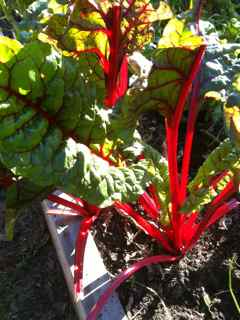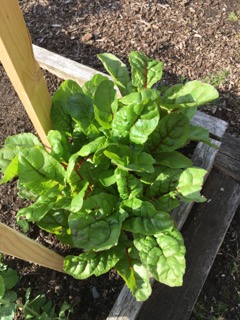Swiss Chard

Swiss Chard is probably the most popular leafy vegetable after spinach for cooking. It is easy to grow and will do well during the spring and summer months.
This vegetable can be direct seeded or transplanted. I like to transplant this vegetable that way there is no thinning to be done on your hands and knees in the garden.
The more you pick off the outer leaves the more the plant will continue to grow. This vegetable will also do well in containers.
Growing Swiss Chard
Botanical Family - Chenopodiaceac/Goose foot
Location - Sunny, well drained.
Soil - Rich, fertile loam with neutral pH 6.5-6.8.
Soil Preparation - Grows well after a green manure crop. Dig in 3 inches of compost or aged manure before planting. Add lime (5 pounds per 50 inches bed) if soil is acidic.
Seed Info
- Seed Spacing - 12 inches apart
- Germinate in soil temperature of 10 - 30 C
- Days to Maturity - 60 days
Planting times - Sow late May; transplant at 4 weeks. Sow mid June to mid July for fall planting. If direct seeding plants will need to be thinned.
Planting Instruction - Likes cool temperatures.
Companion Planting -
- Positive effects: cabbage, celery, eggplant, onion, pea, strawberry
- Negative effects: none
Watering - Water regularly at the base of the plants. If you sprinkle the large leaves may impede water from getting to the soil.
Weeding - Keep weeded while plants are small.
Disease & Insects - cabbage worms, aphids, flea beetle, leaf spot

Harvest -
You can cut the whole plant but usually harvested by cutting outer leaves when they are 6" or more in length.
Leaves can be cut several times during the season. Must be cooled quickly by getting them into refrigerator as soon as possible.
Storage -
This vegetable is best stored in a sealed plastic bag or container in the refrigerator. It is best to use within a few days as it loses nutrients after the first few days.
Swiss Chard Recipe
Swiss Chard Frittata in a Pita
- 4 eggs
- 1 Tbsp. water
- 1 tsp. olive oil
- ¼ cup chopped onions
- ½ tsp minced garlic
- 2 cups packed chopped Swiss chard
- 2 Tbsp. chopped fresh basil or parsley
- ¼ cup grated parmesan cheese
- 2 small 6-inch pita breads
In a small bowl, whisk together eggs and water. Set aside.
In a small 8 inch nonstick skillet, heat oil over medium-high heat. Add onions and garlic; cook for 1 – 2 minutes. Stir in chard and basil (it will cook down; if necessary add the Swiss Chard in 2 batches); cook for 3-4 minutes or until chard is wilted. Remove from pan; set aside.
Add in a small amount of oil and place the skillet over medium heat. Mix the chard and egg mixture together. Pour half the mixture into the skillet. Cook for 3-5 minutes or until browned on the bottom with some of the top still not set; sprinkle with cheese.
Flip frittata over; cook for 1-2 minutes or until browned and completely set. Remove from pan. Repeat procedure with remaining ingredients to make second frittata. Cut pitas in half; place frittata halves inside each pita. Enjoy.
Return from Swiss Chard to Vegetable List
Recent Articles
-
Organic Gardening soil amendments - List of material?
Aug 09, 25 10:57 AM
What materials are best used as organic gardening soil amendments? -
Tips for disease control in your vegetable garden
Jul 14, 25 11:15 AM
Easy tips for disease control to keep your vegetable growing its best. -
Joy of vegetable Gardening
Jul 14, 25 11:01 AM
Everything you need to know is right here to have Joy of Vegetable Gardening





